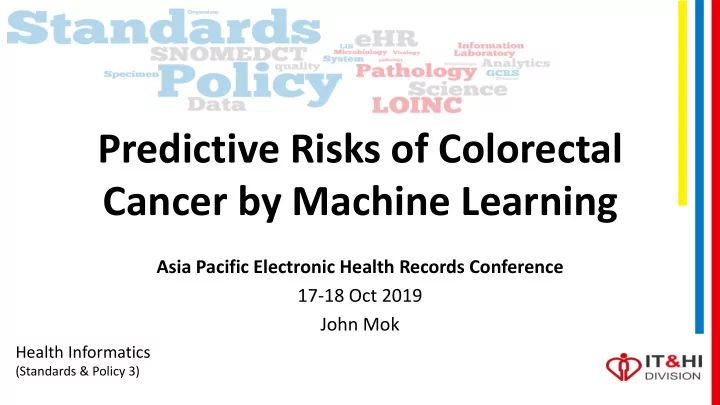

Predictive Risks of Colorectal Cancer by Machine Learning Asia Pacific Electronic Health Records Conference 17-18 Oct 2019 John Mok Health Informatics (Standards & Policy 3)
Acknowledgements • Hong Kong Hospital Authority – Dr NT Cheung, Head and CMIO of IT&HI Division – Ms Vicky Fung, Senior Health Informatician – IT&HI colleagues
Outline • Background • Design • Data science tools – Weka & DataRobot • Results • Lessons learnt
Background • A Proof of Concept study was conducted last year – the objective was to gain some practices in Machine Learning with a clinical use case.
The RESULTS of this paper was our target
Motivation: Colorectal Cancer is more treatable if detected earlier Colorectal cancer is the most Screening / Examination: commonest cancer in HK Faecal Colonoscopy 5437 new cases of colorectal cancer in 2016 occult blood Can ML assist to find unscreened patients at high risk of colorectal cancer? To recommend high risk patients to have a colonoscopy…
Training Dataset Preparation for Predictive Colorectal Cancer by Machine Learning Labelling data with CBC + Age + Sex Histopathology results Results + ve dataset - ve dataset Supervised Machine Learning Predictive risk Local Lab data With ML algorithm, based on very subtle changes in CBC values to predict colorectal cancer
Data Extraction and Labelling CBC data from a local LIS Pathology results Pathology results are are Negative Positive cancer Specimen site is Specimen site is NOT Colorectal Colorectal Class <- Negative Class <- Unknown Class <- Positive Training Dataset: De-identified lab data retrieved from Laboratory Information System of an acute hospital
We tried using AutoML tools for the data modelling.
Data Modelling using Weka
Evaluation Results from Run Information 1. 2. 3. 4. Scheme Tree-J48 RandomForest RandomForest RandomForest +CostSensitiveClassifier (reweighted training) Instances 9708 9708 9708 9708 (Neg-9444; Pos-264) (Neg-9444; Pos-264) (Neg-9444; Pos-264) (Neg-9444; Pos-264) Features 4 4 13 13 (Sex, Age, HGB, Class) (Sex, Age, HGB, Class) (Sex, Age, CBC, Class) (Sex, Age, CBC, Class) Test mode 10-fold CV 10-fold CV 10-fold CV 10-fold CV Classification accuracy 97.84% 97.23% 96.67% 96.70% TP Rate N-1.000; P-0.208 N-0.994; P-0.216 N-0.987; P-0.235 N-0.986; P-0.284 FP Rate N-0.792; P-0.000 N-0.784; P-0.006 N-0.765; P-0.013 N-0.716; P-0.014 Precision N-0.978; P-1.000 N-0.978; P-0.483 N-0.979; P-0.339 N-0.980; P-0.362 Recall N-1.000; P-0.208 N-0.994; P-0.216 N-0.987; P-0.235 N-0.986; P-0.284 F-Measure N-0.989; P-0.345 N-0.986; P-0.298 N-0.983; P-0.277 N-0.983; P-0.319 AUC 0.581 0.685 0.781 0.814
Negative Predictive Value (NPV) – looks good
Rerun the dataset using DataRobot
Automatic Data Modelling
Data Model – Feature Effects
Data Model Evaluation
Lessons learnt • Importance of good quality data for Machine Learning • Heavy work on data Retrieval and Labelling • Features selection requires Domain Knowledge • Validation is critically important • Imbalanced dataset issue • Easy-to-use Data Science tools available for data modelling empowers ordinary people to take machine learning initiatives into their own hands
References • Hornbrook MC, Goshen R, Choman E, O'Keeffe-Rosetti M, Kinar Y, Liles EG, Rust KC. Early Colorectal Cancer Detected by Machine Learning Model Using Gender, Age, and Complete Blood Count Data. Dig Dis Sci. 2017 Oct. • Kinar Y, Kalkstein N, Akiva P, Levin B, Half EE, Goldshtein I, Chodick G, Shalev V. Development and validation of a predictive model for detection of colorectal cancer in primary care by analysis of complete blood counts: a binational retrospective study. J Am Med Inform Assoc. 2016 Sep; 23(5): 879 – 890. • Weka. Waikato Environment for Knowledge Analysis https://www.cs.waikato.ac.nz/ml/weka/index.html • JEN UNDERWOOD . White Paper: Moving from Business Intelligence to Machine Learning with Automation
Recommend
More recommend